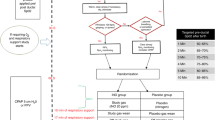Abstract
Inhaled nitric oxide (NO) has been used in the preoperative evaluation of patients with congenital heart disease and pulmonary hypertension. The purpose of this study was to characterize responses in pulmonary vascular resistance (PVR) to oxygen and increasing doses of NO during cardiac catheterization and to determine if any related factors affect the response of the pulmonary vascular bed to NO. A prospective analysis of 42 patients (median age, 3.0 years) with congenital heart disease and pulmonary hypertension who underwent NO testing was performed. Systemic vascular resistance (SVR) and PVR were assessed in room air, 100% oxygen, and oxygen plus 20, 40, and 80 parts per million (ppm) NO. Changes in pulmonary artery pressure, PVR, and SVR were assessed. The response to NO was then correlated to individual patient’s age, gender, type of heart defect, the presence of trisomy 21, and baseline PVR/SVR. There was a greater decrease in PVR and PVR/SVR with 20 ppm NO than with oxygen alone. There was no additional decrease at 40 or 80 ppm NO. There was no correlation between age, gender, type of congenital heart disease, and baseline PVR/SVR ratio with the degree of response to NO. Patients with trisomy 21 had less of a response to NO (p = 0.017) than patients without trisomy 21. There is no difference in determining PVR response with doses of NO beyond 20 ppm during cardiac catheterization. Age, gender, and baseline PVR/SVR ratio are not associated with responsiveness to NO. Patients with trisomy 21 may be less responsive to NO.



Similar content being viewed by others
References
AM Atz I Adatia JE Lock DL Wessel (1999) ArticleTitleCombined effects of nitric oxide and oxygen during acute pulmonary vasodilator testing J Am Coll Cardiol 33 813–819 Occurrence Handle10080486 Occurrence Handle10.1016/S0735-1097(98)00668-8 Occurrence Handle1:STN:280:DyaK1M7nvVGksw%3D%3D
E Azeka JO Costa Auler L Kajita et al. (2002) ArticleTitleEffects of low doses of inhaled nitric oxide combined with oxygen for the evaluation of pulmonary vascular reactivity in patients with pulmonary hypertension Pediatr Cardiol 23 20–26 Occurrence Handle11924533 Occurrence Handle10.1007/s00246-001-0006-2 Occurrence Handle1:STN:280:DC%2BD387ptFSntA%3D%3D
DT Balzer HW Kort RW Day et al. (2002) ArticleTitleInhaled nitric oxide as a preoperative test (INOP test I) Circulation 106 I–76-I-81
M Beghetti W Habre B Friedli M Berner (1995) ArticleTitleContinuous low dose inhaled nitric oxide for treatment of severe pulmonary hypertension after cardiac sugery in paediatric patients Br Heart J 73 65–68 Occurrence Handle7888265 Occurrence Handle1:STN:280:ByqC1Mvnslc%3D
TL Chi LJ Krovetz (1975) ArticleTitleThe pulmonary vascular bed in children with Down syndrome J Pediatr 86 533–538
RD Curran Mavroudis CL Backer et al. (1995) ArticleTitleInhaled nitric oxide for children with congenital heart disease and pulmonary hypertension Ann Thorac Surg 60 1765–1771 Occurrence Handle8787478 Occurrence Handle10.1016/0003-4975(95)00812-8 Occurrence Handle1:STN:280:BymC3M%2FitlI%3D
RW Day JM Lynch RE Shaddy GS Orsmond (1995) ArticleTitlePulmonary vasodilatory effects of 12 and 60 perts per million inhaled nitric oxide in children with ventricular septal defect Am J Cardiol 75 196–198 Occurrence Handle7810506 Occurrence Handle10.1016/S0002-9149(00)80080-6 Occurrence Handle1:STN:280:ByqC3cbltFQ%3D
NN Firmer PC Etches B Kamstra et al. (1994) ArticleTitleInhaled nitric oxide in infants referred for extracorporeal membrane oxygenation: dose response J Pediatr 124 302–308
OI Miller DS Celermajer JE Deanfield DJ Macrae (1994) ArticleTitleVery-low-dose inhaled nitric oxide: a selective pulmonary vasodilator after operations for congenital heart disease J Thorac Cardiovasc Surg 108 487–494 Occurrence Handle8078341 Occurrence Handle1:STN:280:ByuA2Mbis1Y%3D
JD JR Roberts P Lang LM Bigatello GJ Vlahakes WM Zapol (1993) ArticleTitleInhaled nitric oxide in congenital heart disease Circulation 87 447–453 Occurrence Handle8425292
DL Wessel (2001) ArticleTitleCurrent and future strategies in the treatment of childhood pulmonary hypertension Prog Pediatr Cardiol 12 289–318 Occurrence Handle10.1016/S1058-9813(01)00075-3
Author information
Authors and Affiliations
Corresponding author
Rights and permissions
About this article
Cite this article
Cannon, B., Feltes, T., Fraley, J.K. et al. Nitric Oxide in the Evaluation of Congenital Heart Disease with Pulmonary Hypertension: Factors Related to Nitric Oxide Response. Pediatr Cardiol 26, 565–569 (2005). https://doi.org/10.1007/s00246-004-0767-5
Published:
Issue Date:
DOI: https://doi.org/10.1007/s00246-004-0767-5




